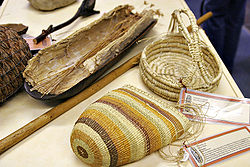Men and women had different but equally important roles within the economic organisation of Indigenous societies.

Aboriginal women's implements, including a coolamon (vessel) lined with paperbark and a digging stick. This woven basket style is from Northern Australia. Baskets were used for collecting fruits, corms, seeds and even water – some baskets were woven so tightly as to be watertight.
The role of men and women in the economy (and in most aspects of Indigenous societies) is one of interdependence and independence. In other words, whilst both sexes relied upon the other, each was able to survive independently of the other when needed. The division of labour was loosely determined by age and sex, with men in the primary role of hunters and women of gatherers. Dingle stresses that “overall women appear to have been more reliable food suppliers than men. Their sources of supply were generally more plentiful and stable. Because they could always feed themselves by gathering whereas men could not always guarantee themselves a meal from hunting, they were also economically more independent than men” (1988, p.13).
Early anthropological accounts viewed women as profoundly oppressed and ‘degraded’ within Aboriginal societies. Later work revealed that this understanding of Aboriginal women’s status was completely incorrect. This more recent work has recovered how women are the custodians of particular realms of knowledge and skills within Indigenous cultures (see for example works by Bell, Berndt and Brock listed in the Reference and Further Reading). Women’s roles included many important functions within the economic organisation of their communities.
Bennet, M. (2007). The Economics of fishing: Sustainable living in colonial New South Wales. Aboriginal History, 31, pp. 85-102, see especially pages 88 and 89.
As you read pages 88 and 89, list the links between the economic activity (fishing) and landscape, gender, spirituality, kinship and territorial rights. (The rest of the article documents how Indigenous people adapted to European economies and is interesting if you wish to read it.)
Bradley, J.& Kearney, A. (2009). Manankurra: What’s in a name? Place names and emotional geographies. In Aboriginal Placenames. Naming and re-naming the Australian landscape. H. Koch and L. Hercus (eds). Pp.463-480. Online: Canberra: ANU E Press.
Land and Economic Life
Choose one of the following calendars that document some Indigenous ecological knowledge that is based around seasons. (They can be quite tricky to read onscreen).
Gooniyandi-Seasons-Calendar
Ngangi-Seasonal-Calendar
Wagiman-Seasons-Calendar
MalakMalak-Plant-Knowledge-Seasons-Calendar
Write a short (3-5 sentence) paragraph that interprets the calendar you have chosen. Think about what you know about economic management and find examples in the calendar you are looking at that show [Note: you might not find examples for each feature].
- Food gathering practices
- Resource management processes
- The landscape
- Movement across the land
- Signs in the landscape
- Links to Dreamings
- Gender differences
- Other features you identify
Now look at this website from the ANU that describes Indigenous ‘scientific’ knowledge in two different cultural groups.
Compare the information on two different sites on the map. Write a short (3-5 sentence) paragraph that interprets the different kinds of knowledge represented here.

|

